It is a fact that nobody in Britain lives more than 70 miles from the coast; as such it surprises me that coarse fishing is more popular than its salty seadog of a cousin. Then, on closer examination, it does not take a genius to work it out.
Let’s first consider the expense of buying bait: I believe a pound of ragworm is now costing upwards of £18 a hundred, lugworm over £20 and peeler crabs 70p each! Then take into account the use of savagely powerful rods that can literally tear the tendons out of their sockets and high speed reels that can blow up into a bird’s nest that would lead a novice Wallis caster to throw a prized centrepin into the river, is it really any wonder?
I suspect for many of us ‘coarse’ anglers sea fishing was perhaps limited to fishing sheltered harbours or feathering for mackerel on those classic British holidays of our childhood…. Oh gosh, I can see I am going to have my work cut out!
I am certain there are more than a few of us on FishingMagic who are a little more enlightened to the pleasures of fishing by the sea and having Alan Yates on the team these days is excellent in that respect but this article is principally aimed at those who would love to give it a go and just need a few starting points. With any luck I hope that it will dispel any myths that some of the sceptics may have, but more importantly encourage a few of you to give it a go!
The European bass
Of all the UK coastal species, the European Bass is the closest thing we have to a ‘sport fish’. Juvenile bass proliferate around Britain’s coasts; moving in vast shoals and they are simply referred to as ‘schoolies’. They are easily distinguished from other fish; with bright silver scales, white belly, large mouth and dorsal array armed with needle sharp spines.
The bass is highly prized by commercial fisherman and has recently been the subject of conservation efforts by recreational fisherman. Bass upwards of 41cm in size are considered big enough to be kept for the table but even this is contentious within the recreational bass fishing community.
For most of their juvenile life schooling bass seek the sanctuary offered by estuaries and don’t venture out to sea until their fourth year; sexual maturity in females is not reached until 42cm in UK waters and individuals of this size may have taken 6-7 years to achieve this size. Much of the adult bass’s life is dictated by seasonal migrations for breeding and finding food.
The first significant in-shore ‘run’ of bass typically occurs sometime around February to June and whilst bass can be caught throughout the summer months the largest individuals are normally taken anytime from September through to November and this is certainly the time of year when I become possessed with ‘bass fever’…
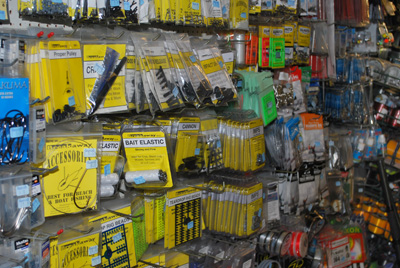 Tackling up for bass
Tackling up for bass
The average coarse angler is equipped to tackle the biggest bass in all but heavy storms or high seas. A standard carp rod of between 2.5 to 3lb, a large fixed spool reel and good quality line of around 15lb is what you need.
Tackling up could not be simpler; due to the harsh nature of the shore, constant wave and tide action it is advisable to add a 50lb breaking strain leader to the main line and as a rule of thumb the length of leader should be about one and a half times the length of the rod.
A simple 2-4oz bullet threaded onto the leader followed by a large plastic bead to protect the knot at the swivel is as simple as it can be and the final piece of the jigsaw is the trace material – I have been using a stiff mono in 25lb breaking strain called Amnesia for years and it still has not been bettered in my opinion.
Hooks are matched to the size of your bait: ragworm can be threaded up and over a relatively small size 1 or 1/0, whilst big baits like squid may require a pair of 6/0 hooks arranged Pennell style. If you want to get ‘riggy’ many anglers I fish with swear by fluorocarbon traces which makes sense in clear water – the bass has excellent vision and can easily spot if something is amiss!
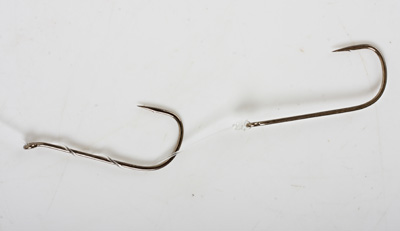 If I had to compare the bass to a coarse species it would be the perch. I have always admired the perch and its tenacity as a bold fighter– only unlike the perch bass can reach weights well over 10lb!!
If I had to compare the bass to a coarse species it would be the perch. I have always admired the perch and its tenacity as a bold fighter– only unlike the perch bass can reach weights well over 10lb!!
The bite is a brutal affair, even a 2lb bass can wrench a rod from a rod rest leading to the unprepared angler chasing a rod down the beach into the surf. Therefore, if I had to treat myself to a single specialist piece of equipment in addition to the standard coarse angler’s armoury, it would be a sturdy tripod.
Last, but not least you will need a book of tide tables for the ‘marks’ you plan to fish. Tides vary in relation to where you live in the country, so it is important to check the tides prior to any visit. In addition to the tide booklets there are now some excellent on-line tide tables which give free 7 day predictions.
Care of tackle: I have used Shimano Baitrunners and other fixed spool reels with confidence on beach, estuary and harbour. The only point of caution is that saltwater is incredibly corrosive. Rods and reels must be washed under fresh tap water to remove all sand, salty water and weed debris immediately after fishing.
It is essential that you regularly check your line for nicks or ‘scratches’ and as good practice I change my line at least every third trip. Bulk spools of line are cheap enough and I could not forgive myself if I lost a fish of a lifetime through just saving a bit of time.
Bait
The best sea fishermen on the match/specialist circuit either dig their own bait, or are indeed professional bait diggers. But this takes a certain level of dedication and travelling expense – especially if that means travelling into the next county to hit a good tide of white ragworm at 1am in the morning and back home for work the same day! Having a family I now much prefer to take a more relaxed attitude to my sea fishing – though I am still partial to digging my own worms and trapping peelers in season. I still have the fridges and freezers – but divorce papers could be pending if they were all fired up (or is that cooled down???) in earnest again!!!
It would not really be possible to produce a comprehensive list of baits suitable for bass as they can be caught using practically anything! If you study the stomach contents of a bass it would appear they are not fussy eaters but to give yourself the best chance always use the freshest and best baits available.
Personally, I find bait collection a rewarding part of the sea fishing experience. This does not just mean digging through estuary mud; there is much to be gained by foraging through rock pools in search of moulting crabs, gobies and live prawns – this is after all why bass are attracted to such areas.
How much bait will I need?
When you consider the expense of buying bait it does make sense to carefully plan your first bass sessions. To fish two rods effectively, a pound of king ragworm and a 1lb box of squid is perfectly adequate and is the ideal starting point. Actual ‘fishing action’ is then dictated by tide movement – little is caught during slack water and it is best to save your bait for when the tide is either ebbing, or flooding.
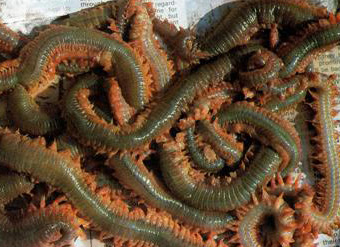 King ragworm
King ragworm
Ragworm are especially productive and take their fair share of big bass. Fresh king rag should be firm, bright red and oozing juices. They are best suited to a size 1 or 1/0 hook; pass the hook point into the mouth and then feed it through the body. The hook point should exit a few inches above the tail so it can wriggle enticingly.
This process can be repeated with two or more worms to produce a juicy mouthful that should have fish literally climbing up your rod. A few words of caution, ragworm have pincers that can give a nip, but worse still are the strong juices that are very painful if they get into little cuts or nicks on your hands.
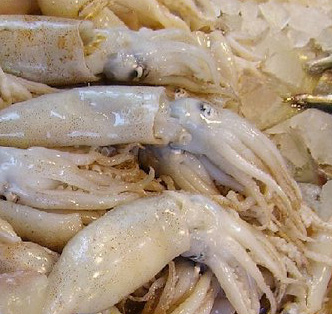 Calamari squid
Calamari squid
I think I have taken more specimen bass on whole squid than any other bait, but for some reason they definitely work better towards the end of the season. You seriously cannot underestimate how big a bass’s mouth is……Even a school bass can engulf a whole Calamari squid. I bulk purchase squid from a local frozen fish wholesaler in convenient 1lb boxes. They keep well in the freezer and are always there at the drop of a hat.
The squid is a big bait and requires a big hook. A size 6/0 hook is threaded through the body of the squid and pulled out through to the head. A little bait elastic ensures that the hook remains locked at the bottom of the bait. A second hook (simply threaded on the trace through the eye and left to slide up and down freely un-aided by a knot of any kind); the trace line is twisted twice around the shank of the hook, and then nicked onto the top of the squid. This Pennell arrangement ensures that a hook is presented both at the top and bottom of the squid.
Livebaiting
Livebaits are probably the most reliable big bass bait but difficult to present effectively. If possible I prefer to suspend a livebait under a float in much the same way I would if I was piking. The two best live baits are gobies and pouting; gobies are small, wriggly little fellows found in rock pools and I would be very surprised if you did not catch a few pouting using ragworm that you can keep alive in a bucket of fresh sea water.
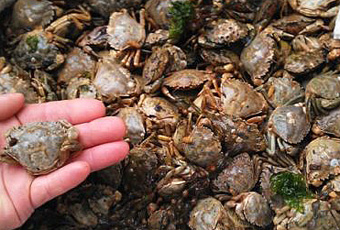 Peeler crab
Peeler crab
Peeler crab is a bass bait par excellence and definitely worth the hassle of finding a few prior to a fishing session. The term peeler crab refers to a specific phase in the lifecycle of the common shore crab. Crabs need to shed their tough outer exoskeleton in order to grow bigger, a process called moulting.
Moulting takes place at different times around the UK anytime from April through to late September. The best place to look for peeler crabs are under rocks that are exposed at low tide. Moulting crabs are far more docile than their fresh shelled brethren, but still capable of giving a sharp nip.
The best way to tell a peeler from a hard shelled crab is to gently pull off the shell around one of the rear legs. If the outer shell reveals a soft, flaccid inner leg, it is a peeler. If the leg section just snaps off, it is a hard back crab and no use for bait. Don’t be too concerned for the poor little critters; they will re-grow a lost limb section on the next moult and will come to no harm.
To prepare a peeler, gently prize off the popping shell of its back, tear off the legs and remove all fragments of the hard shell. Most anglers also have a preference to remove the gills, or dead man’s fingers, that are situated under the newly forming carapace. The bait can be used whole, or cut in half if in short supply. It is fiddly to keep on the hook and therefore needs the use of bait elastic.
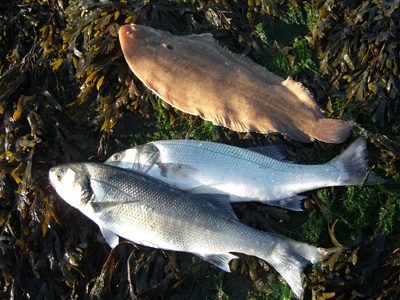 Water craft and catching bass
Water craft and catching bass
Images of beach anglers socialising around their hissing pressure lanterns are detrimental to success. Much like my quarry I seek peace and solitude in my beach fishing and I am very aware that I am encroaching within the environment of a very cautious creature. Much better to keep sound and light down to an absolute minimum – think night fishing for carp or chub and you will be on the right lines – skills well honed by the coarse angler!
It is very difficult to generalise about bass location. On our east coast beaches, breakwaters and rare rocky outcrops are obvious hotspots, but specimen sized fish can turn up literally anywhere. Casting is not really an issue and a carp rod is more than adequate. Indeed, lots of specimen sized bass are landed by novices every year specifically because more experienced anglers can easily cast beyond the feeding zone with more powerful rods.
Bass are bold, brash fish and can practically beach themselves as they harry and strike at bait fish in the surf – a gentle overhead lob of up to 30m is more than adequate. Harbours and estuaries should certainly not be neglected either and can provide cracking sport!
A big part of bass fishing is trying to predict fish movements in relation to the changing tides and moon cycles (I have never been confident fishing on bright, moonlit nights). I don’t want to discuss tides in any great detail other than to suggest that fishing from low tide and the flood can be the most consistent. I like to imagine all the little fry, crabs and prawns being washed out of their little nooks and crannies on a rising tide with bass cruising ready to strike. If a rising tide occurs as darkness begins to fall, or at first light, better still.
Bass are an enigmatic species and notoriously difficult to predict; a specimen in excess of 10lb is truly a ‘fish of a lifetime’. Occasionally, you may even be treated to a red letter day. It is not unusual for bigger bass to be caught in twos, threes or even more! It does seem that often big bass just seem to arrive en masse so it is important to get a bait straight back into the water before the shoal move off, or spook.
My most memorable day’s fishing took place in August, just as dawn was breaking. After a complete night of inactivity, my rod baited with whole calamari squid started nodding gently. A hard strike was met with a strong, angry pulling sensation as I fought for control – the tip bucking wildly. It was obviously a good fish!
There was a bit of swell, so beaching the fish would take some care. I paused the retrieve and waited for an incoming wave to help the struggling fish ashore. This is the point when most good fish are lost. It is important to grab the leader and drag the fish under tension away from the surf. This particular bass was a stunner and weighed 4lb 9oz.
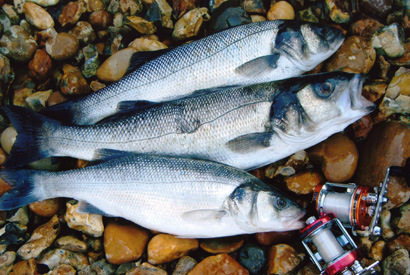
The morning continued with four more bites, two of which attempted to ‘wrench’ the light carp rods towards Davey Jones’ Locker. Sadly two of these fish where lost; one due to a knot failing and a second, the hook simply pulled. Still, fish weighing 3lb 7oz and 3lb 4oz were added to the bag and made this fishing trip a spectacular success.
I suppose the other great thing about sea fishing is that you never really know what you might catch. Fortunately, smaller bass are plentiful and on light tackle will give a good account of themselves and catch the tides right, give reliable sport. Whiting are appearing around some coastal marks all year round and there is always the chance of a good sole. Best of all these diminutive species can provide an enjoyable ‘fight ‘ on light tackle and it is infinitely more enjoyable than keel hauling them using powerful beachcasting rods.
In my heart of hearts I am a river fisherman and always will be but I experience an almost primeval draw towards the sea and the wonderful creatures that inhabit this wonderful environment. I know that coarse fishing can conjure up something of the mystical in mist and dew; but for sheer drama I can think of nothing more enthralling than the sights and sound of the sea striking against shifting, shimmering jewels. Seabirds kiting and shrieking, the sun arising from its distant easterly horizon and a beautiful bass laid upon the shingle, glistening in the light of a new day just dawning.
I hope in sharing this passion I have, perhaps, lit a spark of curiosity. Better still; maybe it will persuade a few you to revisit the sea, or indeed to give bass fishing a go for the first time.
Christian Barker (Chav Professor)












